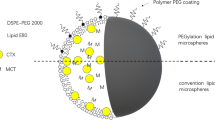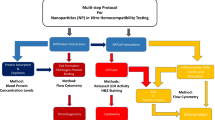Abstract
The aim of this study is to investigate the biocompatibility of polyvinyl alcohol (PVA) embolic microspheres by in vivo and in vitro evaluations. Two specifications of PVA microspheres including colorless microspheres (1 g microspheres with 7 mL 0.9% sodium chloride (SC) per vial, size: 500–700 µm) and blue microspheres (2 g microspheres with 7 mL 0.9% SC per vial, size: 500–700 µm) were assessed for biocompatibility. The vitro cytotoxicity was evaluated in L929 cells by MTT assay. Acute systemic toxicity and 28-repeat dose intravenous subchronic toxicity were assessed in 20 ICR mice and 40 SD rates, respectively. Skin sensitization was conducted in 30 adult albino guinea pigs by maximization test, in addition, intracutaneous reaction test was performed in New Zealand white rabbits. Hemolysis ratio of PVA microspheres was evaluated with rabbit blood. Moreover, test for genotoxicity was assessed by bacterial reverse mutation test and mouse lymphoma mutagenesis assay. No cytotoxicity, hemolysis, or acute toxicity of PVA microspheres was found, and slight fluctuations of biochemical indexes were observed in test of 28-day repeat dose intravenous subchronic toxicity, while these changes remained within our historical permitted range. Maximization test and intracutaneous reactivity test disclosed no irritation to skin or tissues. According to bacterial reverse mutation test and mouse lymphoma mutagenesis assay, no genotoxicity of PVA microspheres was observed. PVA microspheres showed excellent biocompatibility both in vivo and in vitro, and they were promising embolic materials for drug-eluting beads transarterial chemoembolization (DEB-TACE) therapy.






Similar content being viewed by others
References
Luo, S. H., Song, S. L., Zheng, C. S., Li, W. Y., Wang, Y., Xia, X. W., & Feng, G. S. (2017). Embolic effects of Bletilla striata microspheres in renal artery and transplanted VX2 liver tumor model in rabbits. Chinese Journal of Integrative Medicine. https://doi.org/10.1007/s11655-017-2953-3
Jang, J. H., Lee, J. W., Hong, J. T., & Jin, Y. J. (2015). Transarterial chemoembolization for hepatocellular carcinoma: An evidence-based review of its place in therapy. Journal of Hepatocellular Carcinoma, 2, 123–129.
Lencioni, R., de Baere, T., Burrel, M., Caridi, J. G., Lammer, J., Malagari, K., Martin, R. C., O’Grady, E., Real, M. I., Vogl, T. J., Watkinson, A., & Geschwind, J. F. (2012). Transcatheter treatment of hepatocellular carcinoma with Doxorubicin-loaded DC Bead (DEBDOX): Technical recommendations. CardioVascular and Interventional Radiology, 35(5), 980–985.
Fuchs, K., Duran, R., Denys, A., Bize, P. E., Borchard, G., & Jordan, O. (2017). Drug-eluting embolic microspheres for local drug delivery—state of the art. Journal of Controlled Release, 262, 127–138.
Zou, J. H., Zhang, L., Ren, Z. G., & Ye, S. L. (2016). Efficacy and safety of cTACE versus DEB-TACE in patients with hepatocellular carcinoma: A meta-analysis. Journal of Digestive Diseases, 17(8), 510–517.
Malagari, K., Alexopoulou, E., Chatzimichail, K., Hall, B., Koskinas, J., Ryan, S., Gallardo, E., Kelekis, A., Gouliamos, A., & Kelekis, D. (2008). Transcatheter chemoembolization in the treatment of HCC in patients not eligible for curative treatments: Midterm results of doxorubicin-loaded DC bead. Abdominal Imaging, 33(5), 512–519.
Lewis, A. L., Gonzalez, M. V., Lloyd, A. W., Hall, B., Tang, Y., Willis, S. L., Leppard, S. W., Wolfenden, L. C., Palmer, R. R., & Stratford, P. W. (2006). DC bead: In vitro characterization of a drug-delivery device for transarterial chemoembolization. Journal of Vascular & Interventional Radiology, 17(2 Pt 1), 335–342.
Choi, S. Y., Kwak, B. K., Shim, H. J., Lee, J., Hong, S. U., & Kim, K. A. (2015). MRI traceability of superparamagnetic iron oxide nanoparticle-embedded chitosan microspheres as an embolic material in rabbit uterus. Diagnostic and Interventional Radiology, 21(1), 47–53.
Yamamoto, A., Imai, S., Kobatake, M., Yamashita, T., Tamada, T., & Umetani, K. (2006). Evaluation of tris-acryl gelatin microsphere embolization with monochromatic X Rays: Comparison with polyvinyl alcohol particles. Journal of Vascular & Interventional Radiology, 17(11 Pt 1), 1797–1802.
Grumezescu, V., Holban, A. M., Grumezescu, A. M., Socol, G., Ficai, A., Vasile, B. S., Trusca, R., Bleotu, C., Lazar, V., Chifiriuc, C. M., & Mogosanu, G. D. (2014). Usnic acid-loaded biocompatible magnetic PLGA-PVA microsphere thin films fabricated by MAPLE with increased resistance to staphylococcal colonization. Biofabrication, 6(3), 035002.
Puoci, F., Cirillo, G., Curcio, M., Parisi, O. I., Iemma, F., & Picci, N. (2011). Molecularly imprinted polymers in drug delivery: State of art and future perspectives. Expert Opinion on Drug Delivery, 8(10), 1379–1393.
Chen, D. W., Hsu, Y. H., Liao, J. Y., Liu, S. J., Chen, J. K., & Ueng, S. W. (2012). Sustainable release of vancomycin, gentamicin and lidocaine from novel electrospun sandwich-structured PLGA/collagen nanofibrous membranes. International Journal of Pharmaceutics, 430(1–2), 335–341.
Mo, L., Hou, L., Guo, D., Xiao, X., Mao, P., & Yang, X. (2012). Preparation and characterization of teniposide PLGA nanoparticles and their uptake in human glioblastoma U87MG cells. International Journal of Pharmaceutics, 436(1–2), 815–824.
Siskin, G. P., Dowling, K., Virmani, R., Jones, R., & Todd, D. (2003). Pathologic evaluation of a spherical polyvinyl alcohol embolic agent in a porcine renal model. Journal of Vascular & Interventional Radiology, 14(1), 89–98.
Pelage, J. P., Laurent, A., Wassef, M., Bonneau, M., Germain, D., Rymer, R., Flaud, P., Martal, J., & Merland, J. J. (2002). Uterine artery embolization in sheep: Comparison of acute effects with polyvinyl alcohol particles and calibrated microspheres. Radiology, 224(2), 436–445.
Rong, J. J., Liang, M., Xuan, F. Q., Sun, J. Y., Zhao, L. J., Zhen, H. Z., Tian, X. X., Liu, D., Zhang, Q. Y., Peng, C. F., Yao, T. M., Li, F., Wang, X. Z., Han, Y. L., & Yu, W. T. (2015). Alginate-calcium microsphere loaded with thrombin: A new composite biomaterial for hemostatic embolization. International Journal of Biological Macromolecules, 75, 479–488.
Weng, L., Rostamzadeh, P., Nooryshokry, N., Le, H. C., & Golzarian, J. (2013). In vitro and in vivo evaluation of biodegradable embolic microspheres with tunable anticancer drug release. Acta Biomaterialia, 9(6), 6823–6833.
Rong, J. J., Liang, M., Xuan, F. Q., Sun, J. Y., Zhao, L. J., Zheng, H. Z., Tian, X. X., Liu, D., Zhang, Q. Y., Peng, C. F., Li, F., Wang, X. Z., Han, Y. L., & Yu, W. T. (2017). Thrombin-loaded alginate-calcium microspheres: A novel hemostatic embolic material for transcatheter arterial embolization. International Journal of Biological Macromolecules, 104(Pt A), 1302–1312.
Zielhuis, S. W., Nijsen, J. F., Seppenwoolde, J. H., Bakker, C. J., Krijger, G. C., Dullens, H. F., Zonnenberg, B. A., van Rijk, P. P., Hennink, W. E., & van het Schip, A. D. (2007). Long-term toxicity of holmium-loaded poly(L-lactic acid) microspheres in rats. Biomaterials, 28(31), 4591–4599.
Xuan, F., Rong, J., Liang, M., Zhang, X., Sun, J., Zhao, L., Li, Y., Liu, D., Li, F., Wang, X., & Han, Y. (2017). Biocompatibility and effectiveness evaluation of a new hemostatic embolization agent: Thrombin loaded alginate calcium microsphere. BioMed Research International. https://doi.org/10.1155/2017/1875258.
Cui, D. C., Lu, W. L., Sa, E. A., Gu, M. J., Lu, X. J., & Fan, T. Y. (2012). Poly(acrylic acid) microspheres loaded with lidocaine: Preparation and characterization for arterial embolization. International Journal of Pharmaceutics, 436(1–2), 527–535.
Hasan, M. S., Kehoe, S., & Boyd, D. (2014). Temporal analysis of dissolution by-products and genotoxic potential of spherical zinc-silicate bioglass: “Imageable beads” for transarterial embolization. Journal of Biomaterials Applications, 29(4), 566–581.
Kamarudin, N. H., Rahman, R. N., Ali, M. S., Leow, T. C., Basri, M., & Salleh, A. B. (2014). Unscrambling the effect of C-terminal tail deletion on the stability of a cold-adapted, organic solvent stable lipase from Staphylococcus epidermidis AT2. Molecular Biotechnology, 56(8), 747–757.
Nishida, N., Ozato, N., Matsui, K., Kuroda, K., & Ueda, M. (2013). ABC transporters and cell wall proteins involved in organic solvent tolerance in Saccharomyces cerevisiae. Journal of Biotechnology, 165(2), 145–152.
Author information
Authors and Affiliations
Corresponding author
Ethics declarations
Conflict of interest
The authors declare that there are no conflicts of interest.
Additional information
Publisher’s Note
Springer Nature remains neutral with regard to jurisdictional claims in published maps and institutional affiliations.
Electronic supplementary material
Below is the link to the electronic supplementary material.
Rights and permissions
About this article
Cite this article
Sun, X., Dai, H., Guo, P. et al. Biocompatibility of a New Kind of Polyvinyl Alcohol Embolic Microspheres: In Vitro and In Vivo Evaluation. Mol Biotechnol 61, 610–621 (2019). https://doi.org/10.1007/s12033-019-00166-6
Published:
Issue Date:
DOI: https://doi.org/10.1007/s12033-019-00166-6




